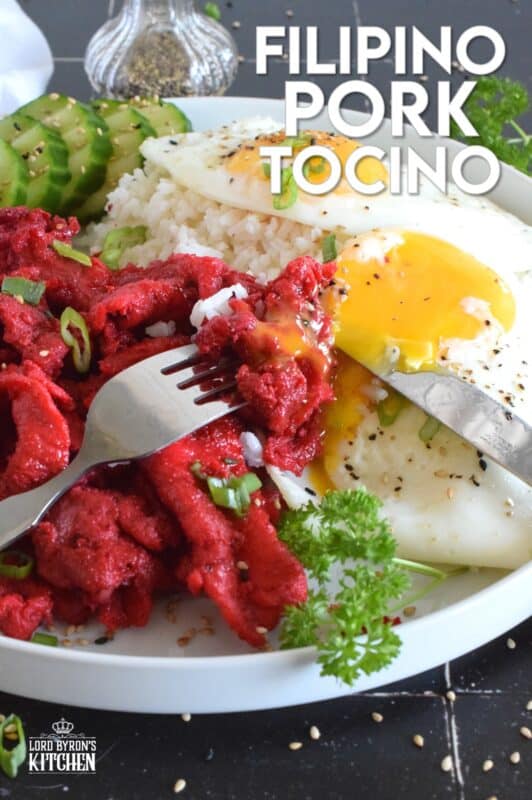One of the easiest and most delicious pork recipes is this Filipino-Style Pork Tocino. Thinly sliced pork is marinated in sugar and seasonings and then pan-fried until tender and fully caramelized. Traditionally served with rice and fried eggs, this recipe is definitely a keeper!

A couple of months ago, we took a drive into town to run a few errands. Usually, whenever there is an errand to run that requires a drive into town, John.e will do it. But, this time, I went along, because going into town means that I can get a Starbucks! On this particular occasion, we also needed groceries and while there, I saw a package of Filipino Pork Tocino in the frozen meat section. I had to have it!
Make your own online recipe box!
Click the in the lower right corner of your screen
& follow the quick and easy instructions!
It had been years since I had seen that bright red packaging! I used to buy it often before life with the vegetarian. A few days later, I decided to have it for dinner. I served it with rice and egg, just like it is usually served for breakfast or lunch in the Philippines, but I wasn’t as happy with it as I had been in the past. It was good, but not fantastic.
I decided to research it and figure out how to make it myself. You see, Dear Reader, it wasn’t so much the flavour of that store-bought tocino as it was the texture. Most of what was in that package was fat. I figured I could make it at home with better quality pork and give my arteries a rest. I’m so glad I did too, because it was absolute perfection! If I didn’t have to worry about vegetarian recipes for John.e, I could prepare this Filipino Pork Tocino at least once a week!

WHAT IS TOCINO?
Tocino, also known as burong babi, is a traditional Filipino dish of sweet cured pork. It’s often made with pork belly, but in my case, I used pork butt, which had much less fat. It is best known as a breakfast dish and is usually served with rice and eggs.
The process of making tocino involves marinating the meat in a mixture of sugar and seasonings. It’s then left to marinate for at least twelve hours. In fact, you can leave it to marinate for 1 to 3 days! You may have noticed that the pork is very red in colour. Back in the day, annatto seeds were added to deepen the red colour and leave a peppery flavour. But many recipes now will call for red food colouring instead.
After the curing process, the pork is cooked in a wok or skillet over medium heat. This gives tocino its characteristic chewiness, drawing out the fat from within the meat, and allowing the brown sugar to give the meat its shiny caramelized coating. There are many variations, such as adding minced garlic, or even using pineapple juice instead of water during cooking.

INGREDIENTS NEEDED FOR THIS RECIPE
The following is a list of the ingredients needed to prepare this Filipino Pork Tocino recipe. For exact amounts and measurements, refer to the printable recipe card located near the bottom of this post.
- Pork Butt or Pork Shoulder – You will need one pound of pork sliced about 1/8th of an inch thick. Remember to slice across the grain!
- Brown Sugar – You can use white granulated sugar as well, but brown sugar has more flavour and adds more caramelization to the finished pork.
- Salt and Ground Black Pepper
- Garlic Powder – Be sure to use garlic powder and not granulated garlic, which is much stronger. You can substitute the garlic powder with one or two cloves of minced fresh garlic if you wish.
- Red Food Colouring – This is what gives the pork that beautiful red colour. You can skip it, but traditionally, tocino is very red!
- Water
- Vegetable Oil
HOW TO MAKE FILIPINO PORK TOCINO
Place the thinly sliced pork into a mixing bowl. Measure in the brown sugar, salt, ground black pepper, and garlic powder, and add a couple of drops of liquid red food colouring. With a gloved hand or tongs, gently massage the pork until the sugar and seasonings are well distributed. The red food colouring may not distribute too well but don’t worry about that. The colour will very easily distribute during cooking. Transfer the pork mixture to a resealable bag. Remove as much air from the bag as possible and refrigerate the pork for a minimum of 12 hours. Pork can be marinated for up to 3 days.
When you are ready to cook the pork, transfer the marinated pork to a skillet or wok. Pour in half a cup of water and turn the heat to medium-high. Stir the pork well and bring the mixture to a boil. Once boiling, lower the heat to simmer and cook until the water is absorbed.
Increase heat to medium-high and add two tablespoons of vegetable oil. Fry, stirring often, until the pork has caramelized slightly. Be careful not to burn the pork! This should only take 2-3 minutes. Once done, serve with rice, fried eggs, and sliced cucumber. Garnish with green onions.

USE PORK BUTT OR PORK SHOULDER
Pork butt and pork shoulder are both cuts that come from the shoulder. Both are relatively inexpensive cuts that lend themselves to low-and-slow cooking such as barbecuing, braising, stewing, etc. They are also perfect for cooking in appliances such as a slow cooker or an Instant Pot.
Pork butt comes from the thicker section of the shoulder and may include the shoulder blade and upper leg. It’s a semi-tough cut of pork that contains a lot of connective tissue and marbling. It is most often purchased with the fat cap attached. Sometimes, this cut is called Boston butt as well.
The pork shoulder, which can also be labelled as picnic shoulder, comes from the thinner, triangle-shaped end of the shoulder, just above the front leg. It has less marbling and fat than pork butt. Pork shoulder is often sold with the skin on and a layer of fat. You can use either in this recipe even though they are most often used in slow cooking recipes. Let me explain why.

PERFECTLY SLICED PORK
When preparing the meat for this Filipino Pork Tocino recipe, you should have one goal. That goal is simple, but it might seem rather difficult to achieve. I’m going to help you reach that goal with minimal effort. Are you ready?
The goal is to have the most tender, moist, flavourful pork. To get that, you will need to do two things. One of those things is to marinate the pork for at least twelve hours. That’s not a surprise though, right? Everyone knows that marinated meat is the best. The second thing you will need to do is to slice the pork as thinly as possible. Well, not paper thin, but as close to 1/8th of an inch as you can get it.
If you have ever tried to slice meat very thinly before, you know that it can be frustrating. It’s soft and it moves around when you push your knife into it. It’s no fun at all! What if I told you that I have a secret to getting the most uniform thinly sliced meat without the use of a meat slicer? Well, I do, and I’m going to share that secret with you.
Wrap the pork in plastic wrap and place it in the freezer. Be sure it is laying flat. Allow it to freeze for one hour. Don’t worry, the pork won’t be frozen rock hard. But, it will be firm and when it’s firm, that’s when you want to slice it. It’s so much easier to do and you can get those uniform slices with ease. Cut across the grain. This will make for a more tender pork dish because you will be cutting across the meat fibres and the marbling.

Do You Like This Recipe?
You should consider trying these other delicious recipes too!





Filipino Pork Tocino
Ingredients
- 1 pound pork butt or pork shoulder, very thinly sliced (about 1/8th inch thick) across the grain
- 1/4 cup brown sugar
- 1/2 teaspoon salt
- 1/2 teaspoon ground black pepper
- 1/2 teaspoon garlic powder
- 2-3 drops red food colouring
- 1/2 cup water
- 1 tablespoons vegetable oil
- green onions, for garnish
Instructions
- Place the thinly sliced pork into a mixing bowl.
- Measure in the brown sugar, salt, ground black pepper, and garlic powder, and add a couple of drops of liquid red food colouring. With a gloved hand or tongs, gently massage the pork until the sugar and seasonings are well distributed. The red food colouring may not distribute too well but don’t worry about that. The colour will very easily distribute during cooking.
- Transfer the pork mixture to a resealable bag. Remove as much air from the bag as possible and refrigerate the pork for a minimum of 12 hours. Pork can be marinated for up to 3 days.
- When you are ready to cook the pork, transfer the marinated pork to a skillet or wok. Pour in half a cup of water and turn the heat to medium-high. Stir the pork well and bring the mixture to a boil. Once boiling, lower the heat to simmer and cook until the water is absorbed.
- Increase heat to medium-high and add two tablespoons of vegetable oil. Fry, stirring often, until the pork has caramelized slightly. Be careful not to burn the pork! This should only take 2-3 minutes.
- Once done, serve with rice, fried eggs, and sliced cucumber. Garnish with green onions.
Nutrition
Did you make this recipe?
Upload a photo and tag me so that I can see it!















Jamie says
Wow! This is such a very classic Filipino Marinated Pork! Everyone in the Philippines loves Tocino! It’s like a staple breakfast dish or any given time of the day! This looks amazingly delicious! I’ll definitely make this at home! Thanks!
Trivia: The plate you’ve posted is called “TOCILOG” (Tocino – Itlog (Egg) – Fried Rice)
Ann says
I have never tried this before, but wow does it sound delicious! I can’t wait to give it a try! Thanks for the recipe share!
Amy Liu Dong says
I love homemade pork tocino and this one is so easy and delicious!
My favorite Filipino breakfast!